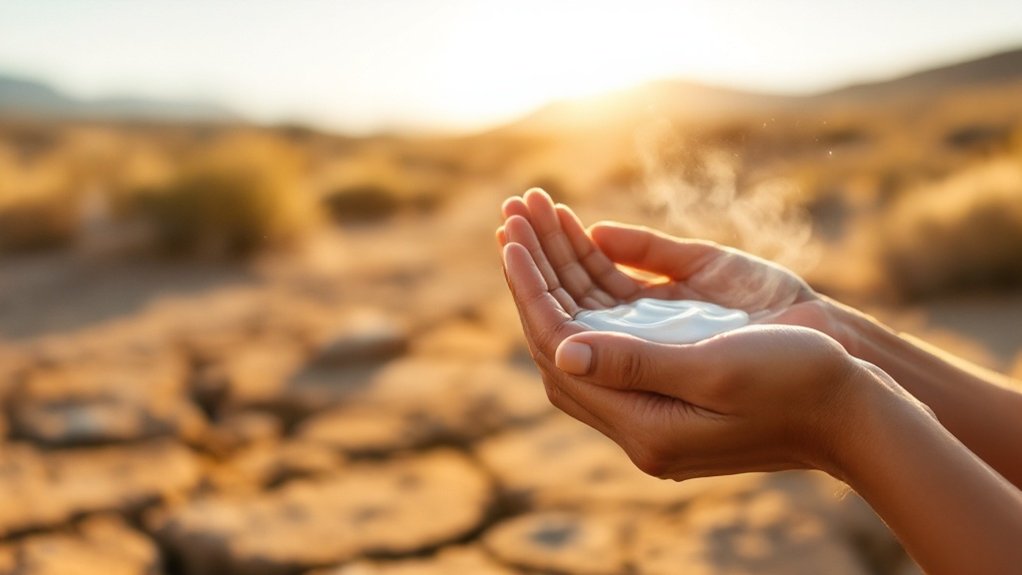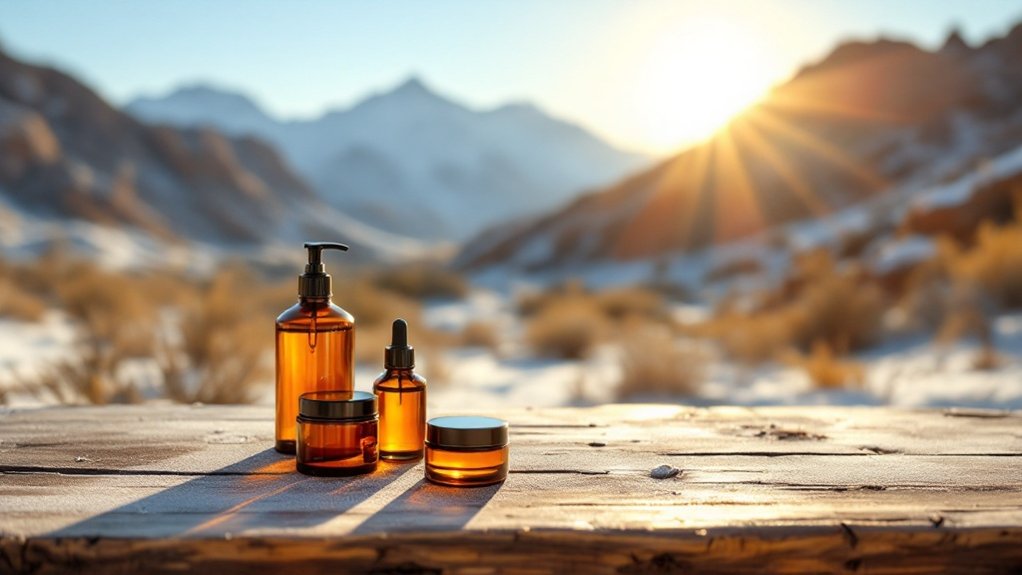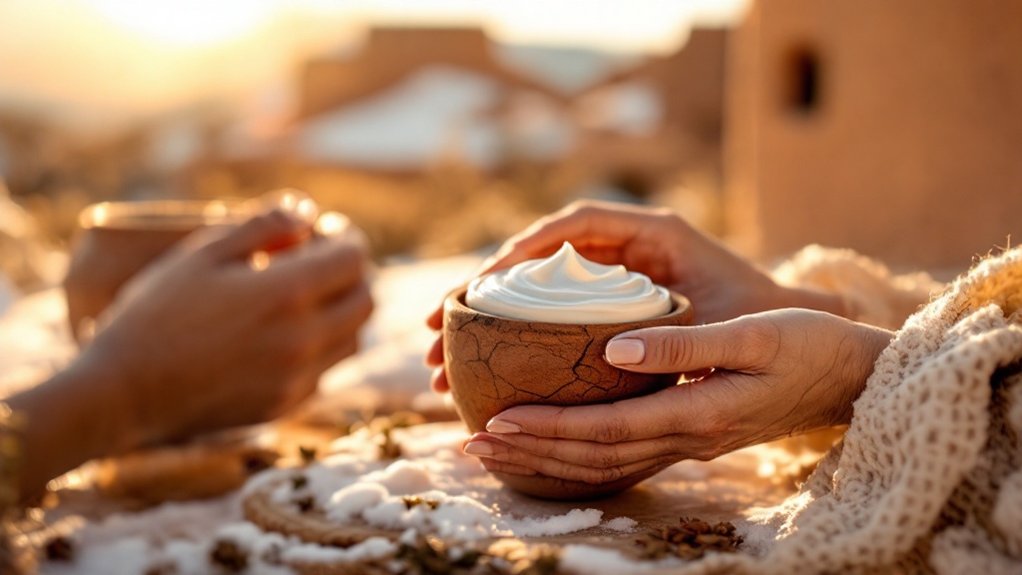Posted by: Skin And Cancer Institute in Medical Dermatology

New Mexico’s high desert climate demands specialized winter skin care due to extreme dryness, temperature fluctuations, and intense UV exposure. We recommend a layered moisture approach: gentle pH-balanced cleansers, multiple weight hyaluronic acids on damp skin, and occlusive moisturizers to seal hydration. Don’t forget daily sun protection regardless of season. Evening recovery protocols should focus on barrier repair using richer formulations. Our all-encompassing strategy addresses both external protection and internal hydration needs.
Key Takeaways
- Layer moisturizing products on damp skin, starting with hydrating essences containing hyaluronic acid and glycerin.
- Use richer face oils and cream formulations to create barriers against extreme temperature fluctuations and low humidity.
- Incorporate gentle, sulfate-free cleansers with pH 4.5-5.5 to preserve the skin’s natural acid mantle.
- Apply broad-spectrum sunscreen year-round due to increased UV exposure at high elevations.
- Increase water intake and consume omega-3 fatty acids to support skin hydration from within.
Understanding the High Desert Climate Challenge

The high desert environment presents a unique challenge for skin health due to its combination of extreme climate factors. New Mexico’s semi-arid to arid climate create a perfect storm for skin moisture depletion, with statewide precipitation averaging only 13.7 inches annually.
We see patients struggling with climate adaptation daily. The region’s extraordinary diurnal temperature swings—often exceeding 32°F between day and night—force skin to constantly adjust. Adding to this stress, our high elevation intensifies UV exposure while the persistent low humidity (with sunshine 80% of days yearly) actively pulls moisture from skin tissues. The clear desert skies amplify UV radiation intensity, making sun protection crucial year-round. This effect is particularly pronounced in the Colorado Plateau region, where the high desert shrublands and volcanic formations create an especially harsh environment for maintaining skin hydration.
Winter brings particular challenges for moisture retention as the already dry air becomes even more moisture-depleting, creating conditions that can quickly compromise your skin’s protective barrier.
The Science of Skin Barrier Function in Arid Environments
While much attention focuses on seasonal changes, understanding the biophysical processes affecting your skin’s barrier function remains vital for effective treatment in our high desert region. Research shows desert dwellers exhibit markedly higher transepidermal water loss values and decreased stratum corneum hydration compared to those in temperate climates.
This compromised barrier function stems from our environment’s low humidity, extreme temperatures, and intense UV exposure. The epidermis must carefully regulate water loss for ideal function, with proteins like filaggrin playing essential roles in skin hydration. Hyaluronic acid molecules perform differently based on day versus night application, making timing crucial for optimal hydration. When environmental stress depletes these natural mechanisms, the skin becomes reactive to irritants and allergens.
Our dermatologists emphasize that consistent barrier repair strategies using appropriate moisturizers show measurably improved outcomes for patients in arid environments like ours, effectively countering these harsh biophysical challenges. Recent research published in September 2023 confirms that regular moisturizer use is linked to significantly improved skin barrier function, with more pronounced benefits observed in desert climates.
Morning Skincare Rituals for Desert Winter Protection

We’ll now examine essential morning skincare practices that protect desert-dwelling individuals during harsh winter conditions. Gentle cleansing methods utilizing lukewarm water and sulfate-free formulations prevent further moisture depletion from already compromised skin barriers. Our recommended layering moisture strategy incorporates multiple hydrating products applied in sequence—starting with lightweight humectants and progressing to occlusive emollients—to create an effective shield against the high desert’s moisture-stripping environment. Including antioxidant-rich products in your morning routine provides crucial protection against UV rays that can penetrate during winter months, especially at New Mexico’s higher elevations. Incorporating products with hyaluronic acid helps maintain optimal moisture levels by attracting and binding water molecules to the skin’s surface.
Gentle Cleansing Methods
During harsh winter months in the high desert, gentle cleansing methods become essential for maintaining skin barrier integrity and preventing moisture loss. We suggest pH-balanced cleansers (4.5-5.5) that preserve your skin’s natural acid mantle against New Mexico’s arid conditions.
Oil-based cleansing provides superior protection by dissolving impurities without stripping beneficial oils. Look for formulations with gentle surfactants like sodium cocoyl glutamate that clean effectively while supporting barrier function. For best results, use lukewarm water (85-90°F) and reduce cleansing frequency to once daily, preferably in the evening.
At Skin and Cancer Institute, we recognize the unique challenges of desert winter skincare. Apply hydrating serums within 60 seconds post-cleanse to lock in moisture before the dry air draws it away. Consider incorporating a botanical skincare line that has been specifically selected for high desert environments to enhance your winter protection routine.
Layering Moisture Strategy
Five essential layers comprise an effective morning skincare ritual for high desert winter protection. We recommend starting with lukewarm water cleansing, as hot water strips natural oils that are vital during winter months. Next, apply hydrating products while skin remains damp to lock in moisture—hyaluronic acid serums work wonderfully as your first moisture layer.
Follow with our Desert Day Cream or Black Serum containing ceramides and glycerin for moisture barrier reinforcement. The fourth layer should include an antioxidant-rich formula like our Mountain Day Cream for high-altitude UV defense. This approach helps prevent the skin barrier damage that occurs when dry environments draw water from deeper skin layers. Finally, seal your moisture layering with a protective sunscreen, even on cloudy days.
This winter hydration strategy addresses the unique challenges our community faces with low humidity, indoor heating, and temperature fluctuations that characterize our beautiful but demanding high desert environment.
Evening Recovery Protocols for Overnight Replenishment
We’ve developed evening recovery protocols that incorporate layered moisture lock technology specifically designed for the high desert climate’s unique challenges. Our Desert Skin Recovery system uses multiple weight hyaluronic acids combined with white truffle extract to create an adaptive barrier that works while you sleep. Overnight Intensive Repair treatments featuring bakuchiol and desert botanicals restore circulation, enhance cellular turnover, and replenish essential moisture stripped away by daytime exposure to frigid air and indoor heating. Gentle cleansers help maintain skin’s natural oils during evening recovery routines, supporting overnight replenishment efforts. For optimal results, we recommend complementing this routine with the Frosty Summit Day Cream which provides essential protection against extreme winter conditions, particularly in New Mexico’s fluctuating temperature patterns.
Layered Moisture Lock
When desert air pulls moisture from your skin overnight, a strategic layering protocol becomes crucial for maintaining barrier function and preventing excessive transepidermal water loss.
We recommend starting with water-based solutions like hydrating essences containing hyaluronic acid and glycerin, which attract and retain water for maximum moisture retention. Allow each product to absorb for several minutes before applying the next layer.
Follow with peptide-rich serums to maintain hydration balance throughout the night, then seal with cream formulations. For severely dry conditions, add face oils as your final step to create an occlusive barrier that locks everything in place. Remember that oils are hydrophobic compounds that sit on the skin’s surface to prevent evaporation of hydration rather than attracting water themselves.
This thinnest-to-thickest approach guarantees active ingredients penetrate effectively while supporting your skin’s natural overnight repair cycles, especially important in our high desert climate.
Desert Skin Recovery
Nighttime represents your skin’s peak recovery window, especially in our high desert climate where environmental stressors deplete moisture throughout the day. At the Skin and Cancer Institute, we recommend a strategic evening protocol to maximize desert hydration.
Apply ceramide-rich creams followed by occlusive balms that seal in moisture while you sleep. Multi-molecular hyaluronic acid serums penetrate deeply, replenishing cells at multiple levels. Dry air conditions at higher altitudes significantly accelerate moisture loss, making overnight replenishment essential. For compromised barriers, we offer professional recovery interventions including SkinVive microdroplet injections that deliver sustained hydration.
Pay special attention to vulnerable areas—eyes, lips, and cheeks—where barrier breakdown happens first. The combination of lower oxygen levels and extreme temperature fluctuations in our high desert requires intentional overnight care. These targeted approaches rebuild skin resilience while you rest, counteracting the cumulative effects of our unique climate.
Overnight Intensive Repair
Your skin’s repair mechanisms function at peak capacity during sleep hours, making evening treatments critical for desert dwellers facing exceptional environmental stress. Our botanical oil-based overnight formulations combine sunflower, jojoba, and rosehip oils with specialized repair agents to penetrate deeply while you rest.
We’ve developed our intensive overnight hydration protocols specifically for the high desert climate, where skin faces extreme dryness and environmental damage. These formulations leverage natural sleep cycles when cellular regeneration accelerates, allowing ingredients like Rosaliss and Defensil Plus to reduce irritation while rebuilding collagen networks. Our Overnight Intensive Repair Balm provides deep nourishment and restoration perfect for skin recovering from harsh environmental exposure.
Our patients report remarkable skin rejuvenation results after just one application. The powerful combination of prebiotics and protective barriers from beeswax and shea butter work together to restore your skin’s microbiome balance while preventing moisture loss throughout the night.
Professional Treatment Options Available in New Mexico
Due to the unique climate conditions found in New Mexico’s high desert, professional dermatological treatments offer targeted solutions for winter skin concerns that at-home regimens can’t fully address. At our practice, we provide advanced treatments like HydraFacials and vitamin-infused therapies that penetrate deeper skin layers for lasting hydration. Maintaining proper indoor humidity levels helps optimize treatment outcomes and prevent skin barrier dysfunction.
Our specialized winter services include Glacial RX Treatment with Cryomodulation™ technology to reduce inflammation while improving serum absorption. Our winter treatment protocol effectively targets age spots or sunspots that appear more pronounced during the drier months. We also recommend professional hydration techniques through our Winter Facial treatments launching December 1st, featuring Glow Boost Stimulating Solution to enhance circulation during colder months.
For thorough skin rejuvenation, we offer microdermabrasion, chemical peels, and collagen-boosting procedures specifically calibrated for high desert conditions. These treatments address texture issues, hyperpigmentation, and premature aging accelerated by our unique climate.
Specialized Product Systems for Altitude and Aridity

While professional treatments address immediate skin concerns, the right product systems provide daily defense against New Mexico’s unique environmental challenges. Our specialized formulations combine desert botanicals like prickly pear and piñon pine with altitude hydration technology to combat the harsh winter climate. Transepidermal water loss is especially concerning at high altitudes where the air is thin and dry.
We recommend multi-layer hydration systems featuring water-based lotions with jojoba oil, specifically designed for altitude-induced dryness. Loam’s Prickly Pear Cactus Lotion contains locally foraged resin for exceptional skin nourishment. The Quench Moisturizer and Luminous Oil deliver exceptional moisture retention in our low-humidity environment. For thorough protection, consider our five-step regimens that include brightening cleansers, dual mist systems, and protective barrier serums.
Local ingredient sourcing remains central to our philosophy, incorporating Chihuahuan Desert botanicals and Jemez Springs lavender into artisanal formulations that address the specific needs of high desert skin conditions.
Diet and Hydration Strategies for Skin Health From Within
The three pillars of ideal skin health in high desert environments extend beyond topical treatments to include internal nourishment strategies. We recommend increasing water intake substantially, as high altitudes accelerate moisture evaporation from your skin at alarming rates.
Implement specialized hydration techniques by consuming water-rich foods like cucumbers and watermelon, which provide cellular moisture support. UV exposure increases 25% per 1,000 feet of elevation, making antioxidant-rich foods essential for protecting against accelerated aging. Thinner atmosphere at higher altitudes allows more harmful UV radiation to reach your skin, requiring additional protective measures. Zinc-rich foods can help support your skin’s natural healing and immunity in this harsh environment.
Optimize nutrient balance with omega-3 fatty acids to strengthen your skin barrier, while limiting caffeine, alcohol, and sodium that contribute to dehydration. We’ve observed remarkable improvements in our patients who incorporate vitamin-rich foods high in C, E, and beta-carotene. You’re part of our community—we’ll help you nourish your skin from within.
Adapting Your Routine Through Seasonal Transitions

Seasonal shifts in high desert climates demand proactive skincare adjustments to maintain ideal skin health throughout the year. We recommend shifting from lighter summer formulations to richer moisturizers as temperatures drop and humidity levels decline. This proactive approach prevents the severe dryness that often develops when summer damage meets winter conditions.
Fall is the prime time for professional treatments like microdermabrasion and chemical peels, which remove accumulated sun damage and prepare your skin for winter’s challenges. As indoor heating systems activate, they greatly reduce ambient moisture, requiring enhanced hydration protocols. Using a portable humidifier in your bedroom can significantly improve skin hydration overnight. Omega-3 rich foods can help reduce skin inflammation and maintain hydration from the inside out. Monitor for increased skin sensitivity during these changing periods—flaking, tightness, or rough patches indicate immediate intervention is needed. Incorporating overnight masks and hyaluronic acid serums during autumn can effectively bridge the gap between seasonal skincare requirements.
Traditional New Mexican Remedies for Winter Skin Care
Indigenous wisdom from New Mexico’s healing traditions offers remarkable benefits for skin protection during harsh winter months. These time-tested remedies align perfectly with modern dermatological understanding of winter skin needs.
We recommend incorporating herbal infusions of aloe vera and calendula, which provide exceptional hydration and anti-inflammatory benefits. Curanderismo approaches emphasize holistic skin rituals that address the gut-brain-skin network, essential for thorough healing. The efficacy of these treatments comes from a deep understanding of native plants and their therapeutic properties.
For environmental protection, traditional remedies utilize antioxidant-rich plants specifically adapted to high desert conditions. These formulations address both UV exposure at higher altitudes and extreme dryness. Oil-based treatments containing camphor create protective barriers against harsh winds, while copal tree extracts and chamomile reduce inflammation and redness—common winter skin complaints in our region’s unique climate.
Frequently Asked Questions
How Does Desert Skincare Differ From Humid Climate Skincare Regimens?
We recommend richer moisturizers and heavier creams in desert areas versus lightweight gel-based formulas for humid climates. Sunscreen importance is heightened in desert environments due to increased UV exposure.
Can Certain Medications Increase Sensitivity to High Desert Conditions?
Yes, we’ve observed that antibiotics, cardiovascular medications, NSAIDs, and psychiatric drugs can considerably increase sensitivity to high desert conditions, causing severe skin reactions including photosensitivity, rashes, burns, and persistent discoloration.
How Often Should I Exfoliate in New Mexico’s Winter Climate?
We recommend limiting exfoliation frequency to 1-2 times weekly in New Mexico’s winter. The high desert climate already stresses your skin barrier, so gentle exfoliation helps maintain proper skin cell turnover without causing irritation.
Are There Specific Fabrics That Protect Skin in High Desert Environments?
Yes. We recommend UPF-rated synthetics like polyester and nylon for ideal protection. Thermal clothing with moisture wicking fabrics draws perspiration away while maintaining a protective barrier against harsh desert conditions.
Do Indoor Plants Help Counteract Dry Skin From Heating Systems?
Yes, indoor plants increase humidity through transpiration, helping counteract dry air from heating systems. We recommend placing moisture-releasing varieties like peace lilies near your living spaces for improved skin moisture retention.
Conclusion
We’ve outlined essential strategies for protecting and nourishing your skin through New Mexico’s challenging winter climate. By understanding the unique demands of high desert environments, implementing targeted morning and evening routines, and supporting skin health internally, you’ll maintain ideal barrier function despite harsh conditions. Don’t hesitate to schedule a consultation for personalized recommendations that address your specific skin concerns during these arid winter months.